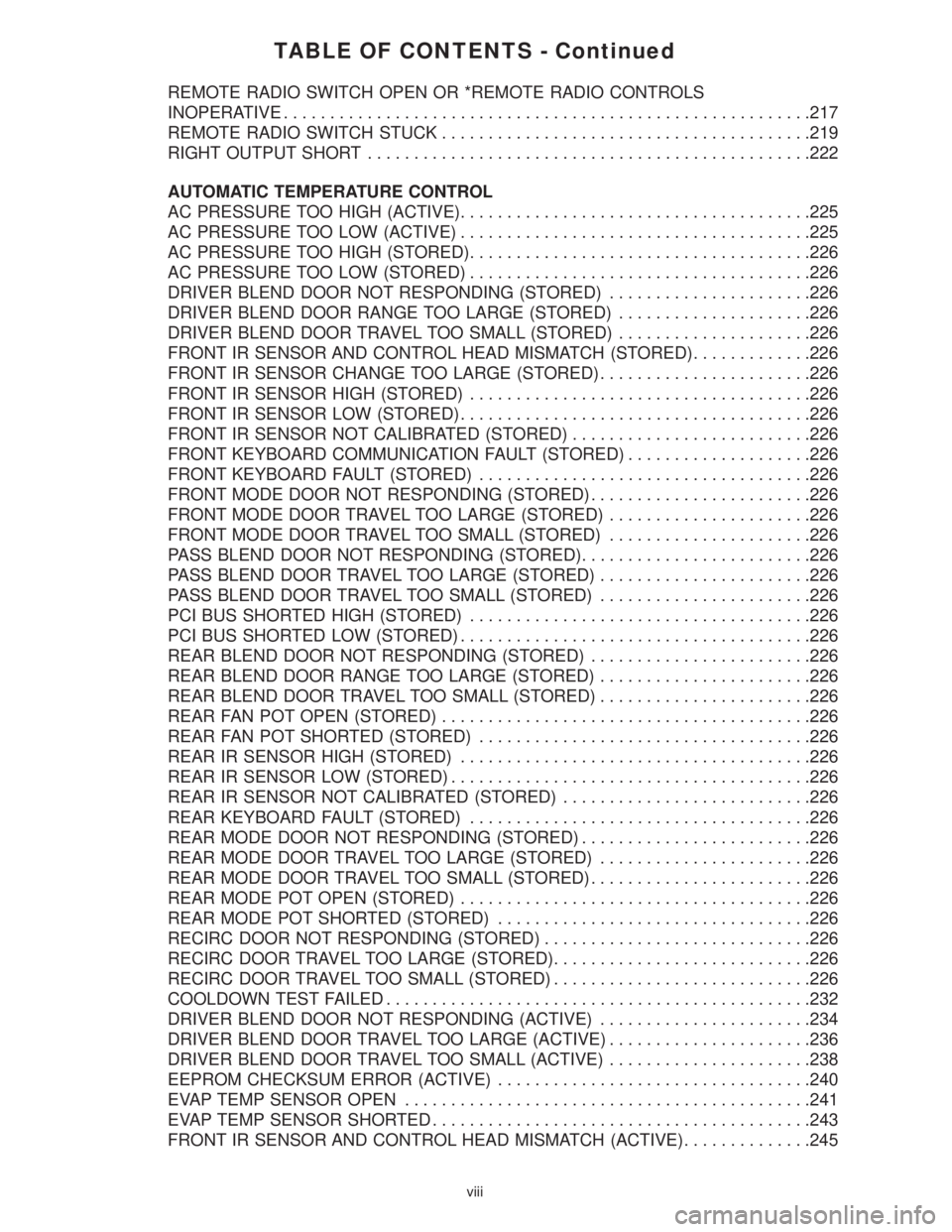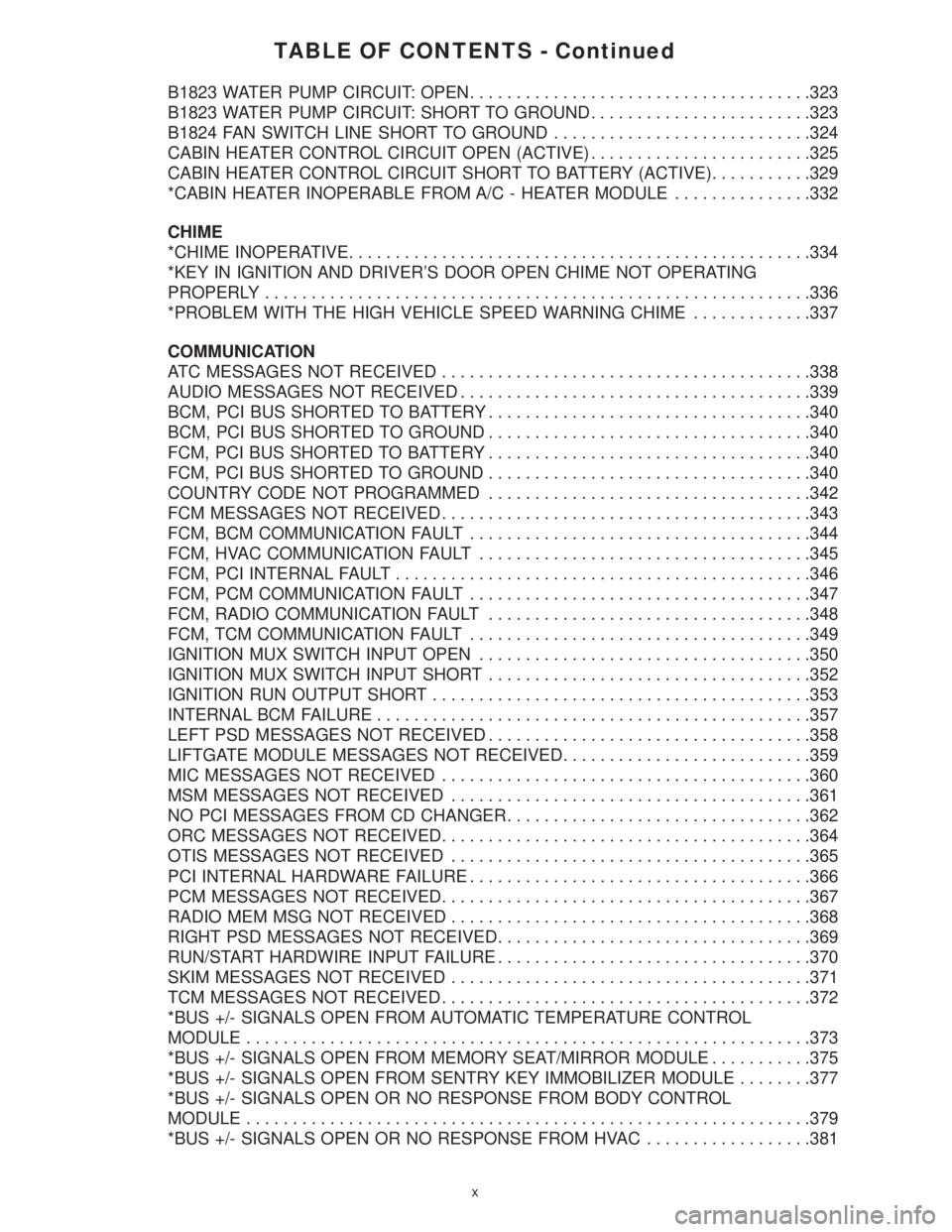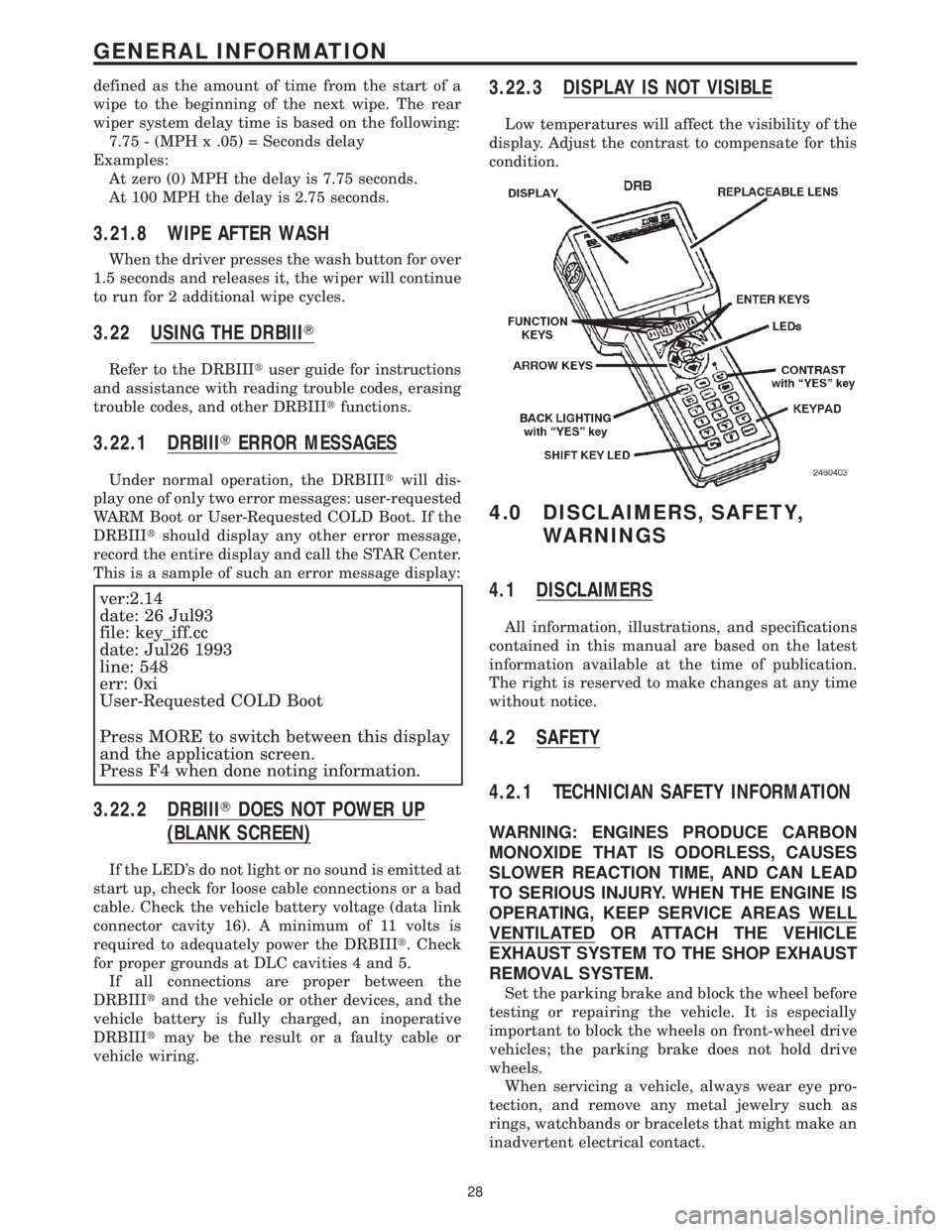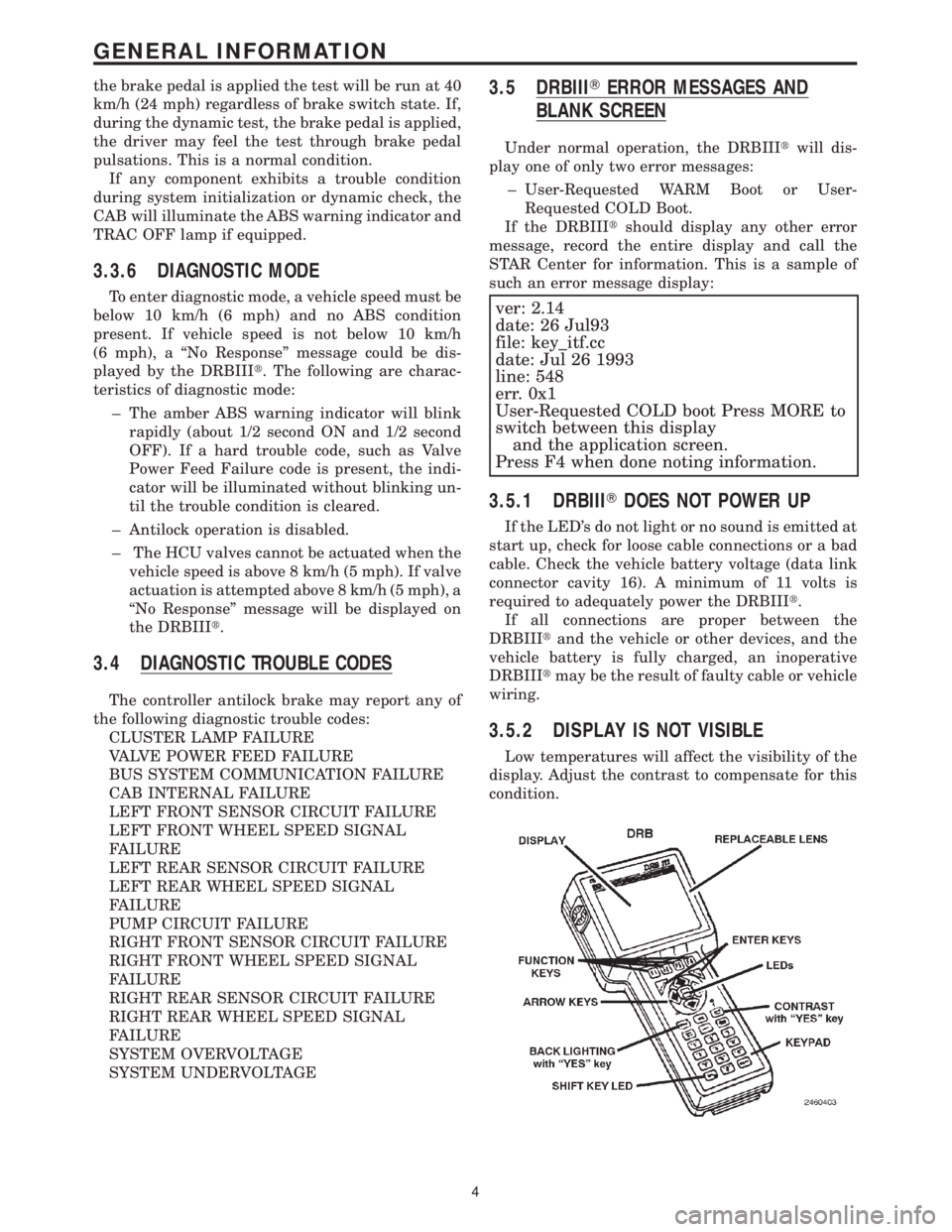2001 CHRYSLER VOYAGER ESP inoperative
[x] Cancel search: ESP inoperativePage 11 of 4284

TABLE OF CONTENTS - Continued
REMOTE RADIO SWITCH OPEN OR *REMOTE RADIO CONTROLS
INOPERATIVE.........................................................217
REMOTE RADIO SWITCH STUCK........................................219
RIGHT OUTPUT SHORT................................................222
AUTOMATIC TEMPERATURE CONTROL
AC PRESSURE TOO HIGH (ACTIVE)......................................225
AC PRESSURE TOO LOW (ACTIVE)......................................225
AC PRESSURE TOO HIGH (STORED).....................................226
AC PRESSURE TOO LOW (STORED).....................................226
DRIVER BLEND DOOR NOT RESPONDING (STORED)......................226
DRIVER BLEND DOOR RANGE TOO LARGE (STORED).....................226
DRIVER BLEND DOOR TRAVEL TOO SMALL (STORED).....................226
FRONT IR SENSOR AND CONTROL HEAD MISMATCH (STORED).............226
FRONT IR SENSOR CHANGE TOO LARGE (STORED).......................226
FRONT IR SENSOR HIGH (STORED).....................................226
FRONT IR SENSOR LOW (STORED)......................................226
FRONT IR SENSOR NOT CALIBRATED (STORED)..........................226
FRONT KEYBOARD COMMUNICATION FAULT (STORED)....................226
FRONT KEYBOARD FAULT (STORED)....................................226
FRONT MODE DOOR NOT RESPONDING (STORED)........................226
FRONT MODE DOOR TRAVEL TOO LARGE (STORED)......................226
FRONT MODE DOOR TRAVEL TOO SMALL (STORED)......................226
PASS BLEND DOOR NOT RESPONDING (STORED).........................226
PASS BLEND DOOR TRAVEL TOO LARGE (STORED).......................226
PASS BLEND DOOR TRAVEL TOO SMALL (STORED).......................226
PCI BUS SHORTED HIGH (STORED).....................................226
PCI BUS SHORTED LOW (STORED)......................................226
REAR BLEND DOOR NOT RESPONDING (STORED)........................226
REAR BLEND DOOR RANGE TOO LARGE (STORED).......................226
REAR BLEND DOOR TRAVEL TOO SMALL (STORED).......................226
REAR FAN POT OPEN (STORED)........................................226
REAR FAN POT SHORTED (STORED)....................................226
REAR IR SENSOR HIGH (STORED)......................................226
REAR IR SENSOR LOW (STORED).......................................226
REAR IR SENSOR NOT CALIBRATED (STORED)...........................226
REAR KEYBOARD FAULT (STORED).....................................226
REAR MODE DOOR NOT RESPONDING (STORED).........................226
REAR MODE DOOR TRAVEL TOO LARGE (STORED).......................226
REAR MODE DOOR TRAVEL TOO SMALL (STORED)........................226
REAR MODE POT OPEN (STORED)......................................226
REAR MODE POT SHORTED (STORED)..................................226
RECIRC DOOR NOT RESPONDING (STORED).............................226
RECIRC DOOR TRAVEL TOO LARGE (STORED)............................226
RECIRC DOOR TRAVEL TOO SMALL (STORED)............................226
COOLDOWN TEST FAILED..............................................232
DRIVER BLEND DOOR NOT RESPONDING (ACTIVE).......................234
DRIVER BLEND DOOR TRAVEL TOO LARGE (ACTIVE)......................236
DRIVER BLEND DOOR TRAVEL TOO SMALL (ACTIVE)......................238
EEPROM CHECKSUM ERROR (ACTIVE)..................................240
EVAP TEMP SENSOR OPEN............................................241
EVAP TEMP SENSOR SHORTED.........................................243
FRONT IR SENSOR AND CONTROL HEAD MISMATCH (ACTIVE)..............245
viii
Page 13 of 4284

TABLE OF CONTENTS - Continued
B1823 WATER PUMP CIRCUIT: OPEN.....................................323
B1823 WATER PUMP CIRCUIT: SHORT TO GROUND........................323
B1824 FAN SWITCH LINE SHORT TO GROUND............................324
CABIN HEATER CONTROL CIRCUIT OPEN (ACTIVE)........................325
CABIN HEATER CONTROL CIRCUIT SHORT TO BATTERY (ACTIVE)...........329
*CABIN HEATER INOPERABLE FROM A/C - HEATER MODULE...............332
CHIME
*CHIME INOPERATIVE..................................................334
*KEY IN IGNITION AND DRIVER'S DOOR OPEN CHIME NOT OPERATING
PROPERLY...........................................................336
*PROBLEM WITH THE HIGH VEHICLE SPEED WARNING CHIME.............337
COMMUNICATION
ATC MESSAGES NOT RECEIVED........................................338
AUDIO MESSAGES NOT RECEIVED......................................339
BCM, PCI BUS SHORTED TO BATTERY...................................340
BCM, PCI BUS SHORTED TO GROUND...................................340
FCM, PCI BUS SHORTED TO BATTERY...................................340
FCM, PCI BUS SHORTED TO GROUND...................................340
COUNTRY CODE NOT PROGRAMMED...................................342
FCM MESSAGES NOT RECEIVED........................................343
FCM, BCM COMMUNICATION FAULT.....................................344
FCM, HVAC COMMUNICATION FAULT....................................345
FCM, PCI INTERNAL FAULT.............................................346
FCM, PCM COMMUNICATION FAULT.....................................347
FCM, RADIO COMMUNICATION FAULT...................................348
FCM, TCM COMMUNICATION FAULT.....................................349
IGNITION MUX SWITCH INPUT OPEN....................................350
IGNITION MUX SWITCH INPUT SHORT...................................352
IGNITION RUN OUTPUT SHORT.........................................353
INTERNAL BCM FAILURE...............................................357
LEFT PSD MESSAGES NOT RECEIVED...................................358
LIFTGATE MODULE MESSAGES NOT RECEIVED...........................359
MIC MESSAGES NOT RECEIVED........................................360
MSM MESSAGES NOT RECEIVED.......................................361
NO PCI MESSAGES FROM CD CHANGER.................................362
ORC MESSAGES NOT RECEIVED........................................364
OTIS MESSAGES NOT RECEIVED.......................................365
PCI INTERNAL HARDWARE FAILURE.....................................366
PCM MESSAGES NOT RECEIVED........................................367
RADIO MEM MSG NOT RECEIVED.......................................368
RIGHT PSD MESSAGES NOT RECEIVED..................................369
RUN/START HARDWIRE INPUT FAILURE..................................370
SKIM MESSAGES NOT RECEIVED.......................................371
TCM MESSAGES NOT RECEIVED........................................372
*BUS +/- SIGNALS OPEN FROM AUTOMATIC TEMPERATURE CONTROL
MODULE.............................................................373
*BUS +/- SIGNALS OPEN FROM MEMORY SEAT/MIRROR MODULE...........375
*BUS +/- SIGNALS OPEN FROM SENTRY KEY IMMOBILIZER MODULE........377
*BUS +/- SIGNALS OPEN OR NO RESPONSE FROM BODY CONTROL
MODULE.............................................................379
*BUS +/- SIGNALS OPEN OR NO RESPONSE FROM HVAC..................381
x
Page 51 of 4284

On vehicles equipped with AutoStick, the display
includes an O/D OFF indicator that is illuminated
when the driver presses the Overdrive Off button
on the transaxle shifter.
3.11.1 INSTRUMENT CLUSTER SELF TEST
1. Depress and hold the Odometer Reset button.
2. Turn the ignition switch to the RUN/START
position.
3. Release the Odometer reset button.
The Instrument Cluster will illuminate all indi-
cators and step the gauges through several calibra-
tion points. Also, the odometer will display any
stored codes that may have set.
3.11.2 MESSAGE CENTER
The Message Center is located above the brow of
the Instrument Cluster. It houses the following
warning indicators: Check Engine/Service Engine
Soon, high beam, left and right turn signals, Secu-
rity Alarm Set, and low oil pressure. On base
models equipped with the three-speed transaxle,
these indicators appear in the face of the cluster.
The Security Alarm set indicator is a red circle.
Activation of Instrument Cluster indicators is
coordinated with indicators in the message center
and EVIC to avoid redundancy. A revised safety
standard now requires that the seat belt warning
lamp in the Instrument Cluster remain lit if the
driver seat belt is not buckled. A headlamp out ISO
indicator has been added to the Instrument Cluster
to alert the driver when a headlamp is not function-
ing.
3.12 INTERIOR LIGHTING
3.12.1 COURTESY LAMP CONTROL
The body controller has direct control over all of
the vehicle's courtesy lamps. The body computer
will illuminate the courtesy lamps under any of the
following conditions:
1. Any door ajar and courtesy lamp switch on the
headlamp switch is not in the dome off position.
2. The courtesy lamp switch on the headlamp
switch is in the dome on position.
3. A Remote Keyless Entry unlock message is re-
ceived.
4. Driver door unlocked with key (with VTSS only).
3.12.2 ILLUMINATED ENTRY
Illuminated entry will be initiated when the cus-
tomer enters the vehicle by unlocking the doors
with the key fob, or with the key if the vehicle is
equipped with vehicle theft alarm. Upon exiting thevehicle, if the lock button is pressed with a door
open, illuminated entry will cancel when the door
closes. If the doors are closed and the ignition
switch is turned on, the illuminated entry also
cancels. The illuminated entry feature will not
operate if the courtesy lamp switch is in the dome
off position.
3.12.3 INTERIOR LIGHTING BATTERY
SAVER
If any of the interior lamps are left on after the
ignition is turned off, the BCM will turn them off
after 8 minutes. To return to normal operation, the
courtesy lamps will operate after the dome lamp
switch or door ajar switch changes state. The glove
box and switched reading lamps require that the
ignition be turned to the on/acc position.
3.13 MEMORY SYSTEM
The memory system consists of power driver 's
seat, power mirrors and radio presets. The Memory
Seat/Mirror Module (MSMM) is located under the
driver 's seat. It receives input from the following:
driver 's manual 8-way seat switch, driver 's seat
position sensors, PCI bus circuits, and the power
mirror sensors. The module uses these inputs to
perform the following functions: position the driv-
er 's memory seat, both exterior mirrors (during
recalls), and send/receive the memory system infor-
mation over the PCI bus.
The Memory Set Switch is wired to the Body
Control Module (BCM). When a button (either #1 or
#2) is pressed on the set switch causes the to BCM
send a message to the MSMM which in turn sends
a motion status messages to the BCM. If the BCM
receives no motion from the MSMM it will send a
recall message to the MSMM and radio (once igni-
tion is in run or accessory). The MSMM will in turn
position the drivers seat, both mirrors along with
recalling the radio presets. If the drivers seat or
either exterior mirror is inoperative from its own
respective switches, use the service information
and schematic to diagnose the problem. This man-
ual addresses the memory problems only and it is
assumed there is not a basic component failure.
3.13.1 POWER SEAT
The memory power seat provides the driver with
2 position settings for the driver 's seat. Each power
seat motor is connected to the MSMM with two
motor drive circuits. Each circuit is switched be-
tween battery and ground. By being able to bi-
directionally drive the circuits, the MSMM controls
the movement of the motors based on input from
the power seat switch or from the position sensors
when performing a memory recall. Each motor
22
GENERAL INFORMATION
Page 57 of 4284

defined as the amount of time from the start of a
wipe to the beginning of the next wipe. The rear
wiper system delay time is based on the following:
7.75 - (MPH x .05) = Seconds delay
Examples:
At zero (0) MPH the delay is 7.75 seconds.
At 100 MPH the delay is 2.75 seconds.
3.21.8 WIPE AFTER WASH
When the driver presses the wash button for over
1.5 seconds and releases it, the wiper will continue
to run for 2 additional wipe cycles.
3.22 USING THE DRBIIIT
Refer to the DRBIIItuser guide for instructions
and assistance with reading trouble codes, erasing
trouble codes, and other DRBIIItfunctions.
3.22.1 DRBIIITERROR MESSAGES
Under normal operation, the DRBIIItwill dis-
play one of only two error messages: user-requested
WARM Boot or User-Requested COLD Boot. If the
DRBIIItshould display any other error message,
record the entire display and call the STAR Center.
This is a sample of such an error message display:
ver:2.14
date: 26 Jul93
file: key_iff.cc
date: Jul26 1993
line: 548
err: 0xi
User-Requested COLD Boot
Press MORE to switch between this display
and the application screen.
Press F4 when done noting information.
3.22.2 DRBIIITDOES NOT POWER UP
(BLANK SCREEN)
If the LED's do not light or no sound is emitted at
start up, check for loose cable connections or a bad
cable. Check the vehicle battery voltage (data link
connector cavity 16). A minimum of 11 volts is
required to adequately power the DRBIIIt. Check
for proper grounds at DLC cavities 4 and 5.
If all connections are proper between the
DRBIIItand the vehicle or other devices, and the
vehicle battery is fully charged, an inoperative
DRBIIItmay be the result or a faulty cable or
vehicle wiring.
3.22.3 DISPLAY IS NOT VISIBLE
Low temperatures will affect the visibility of the
display. Adjust the contrast to compensate for this
condition.
4.0 DISCLAIMERS, SAFETY,
WARNINGS
4.1 DISCLAIMERS
All information, illustrations, and specifications
contained in this manual are based on the latest
information available at the time of publication.
The right is reserved to make changes at any time
without notice.
4.2 SAFETY
4.2.1 TECHNICIAN SAFETY INFORMATION
WARNING: ENGINES PRODUCE CARBON
MONOXIDE THAT IS ODORLESS, CAUSES
SLOWER REACTION TIME, AND CAN LEAD
TO SERIOUS INJURY. WHEN THE ENGINE IS
OPERATING, KEEP SERVICE AREAS WELL
VENTILATED OR ATTACH THE VEHICLE
EXHAUST SYSTEM TO THE SHOP EXHAUST
REMOVAL SYSTEM.
Set the parking brake and block the wheel before
testing or repairing the vehicle. It is especially
important to block the wheels on front-wheel drive
vehicles; the parking brake does not hold drive
wheels.
When servicing a vehicle, always wear eye pro-
tection, and remove any metal jewelry such as
rings, watchbands or bracelets that might make an
inadvertent electrical contact.
28
GENERAL INFORMATION
Page 645 of 4284

Symptom:
*ANY PCI BUS INDICATOR INOPERATIVE
POSSIBLE CAUSES
NO RESPONSE - PCI BUS
NO RESPONSE - INSTRUMENT CLUSTER
NO RESPONSE - ECM / PCM
INDICATOR INOPERATIVE
INSTRUMENT CLUSTER
TEST ACTION APPLICABILITY
1 Turn the ignition on.
With the DRBIIIt, select J1850 Module Scan.
Does the DRBIIItdisplay MIC PRESENT on the BUS?All
Ye s®Go To 2
No®Refer to the COMMUNICATION category and perform the ap-
propriate symptom.
Perform BODY VERIFICATION TEST - VER 1.
2 Turn the ignition on.
With the DRBIIIt, Select Body, MIC, the MODULE DISPLAY.
Does the DRBIIItdisplay NO RESPONSE from MIC?All
Ye s®Refer to the symptom list for problems related to *NO RE-
SPONSE FROM THE INSTRUMENT CLUSTER.
Perform BODY VERIFICATION TEST - VER 1.
No®Go To 3
3 Turn the ignition on.
With the DRBIIIt, select Body, MIC, SYSTEM TESTS, PCM MONITOR.
Does the DRBIIItdisplay PCM INACTIVE on the BUS?All
Ye s®Refer to the symptom list for problems related to *NO RE-
SPONSE FROM THE POWERTRAIN CONTROL MODULE
(Gas) / or *NO RESPONSE FROM THE ENGINE CONTROL
MODULE (Diesel)
Perform BODY VERIFICATION TEST - VER 1.
No®Go To 4
4NOTE: Diagnose and repair any PCM (gas) or ECM (diesel) DTCs before
proceeding with this test.
Perform the Instrument Cluster diagnostic Self Test.
Observe the indicator in question during the Self Test.
Did the indicator illuminate?All
Ye s®Refer to the appropriate Servic Information category to diagnose
the related system.
Perform BODY VERIFICATION TEST - VER 1.
No®Replace the Instrument Cluster in accordance with the Service
Information.
Perform BODY VERIFICATION TEST - VER 1.
616
INSTRUMENT CLUSTER
Page 862 of 4284

Symptom:
*POWER LIFTGATE INOPERATIVE
POSSIBLE CAUSES
DTC'S PRESENT
MODULE RESPONSE
INTERMITTENT PROBLEM
SYSTEM TESTS
TEST ACTION APPLICABILITY
1 With the DRBIIItcheck for response from the Body Computer and the Power
Liftgate Modules
Is there response from both modules?All
Ye s®Go To 2
No®Refer to symptom list for problems related to COMMUNICA-
TION.
2 With the DRBIIIt, read DTCs in POWER LIFTGATE and BODY COMPUTER.
Are any Power Liftgate related codes present?All
Ye s®Refer to symptom list for problems related to POWER LIFT-
GATE.
No®Go To 3
3 This test will determine what inhibited the Power Liftgate from operating properly.
With the DRBIIIt, select POWER LIFTGATE, MISCELLANEOUS, LAST INHIBIT
MONITOR.
Does the DRBIIItdisplay any INHIBIT REASONS?All
Ye s®Check for any binding conditions or other restrictions that may
prevent proper operation. Using the wiring diagram/schematic as
a guide, inspect the wiring and connectors.
No®Go To 4
4 Ensure Liftgate is fully closed before proceeding.
With the DRBIIItselect SYSTEM TEST.
Perform the Open, Close, Latch Cinch, Latch Release and Relay tests.
Did any test fail?All
Ye s®Using the wiring diagram/schematic as a guide, inspect the
wiring and connectors.
No®Test Complete.
833
POWER DOORS - LIFTGATE
Page 936 of 4284

Symptom:
*POWER SLIDING DOOR INOPERATIVE
POSSIBLE CAUSES
DTC'S PRESENT
MODULE RESPONSE
INTERMITTENT PROBLEM
SYSTEM TESTS
TEST ACTION APPLICABILITY
1 With the DRBIIItcheck for response from the Body Computer and the Power Sliding
Door Modules
Is there response from both modules?All
Ye s®Go To 2
No®Refer to symptom list for problems related to COMMUNICA-
TION.
2 With the DRBIIIt, read DTCs in POWER SLIDING DOOR and BODY COMPUTER.
Are any Power Sliding Door related codes present?All
Ye s®Refer to symptom list for problems related to POWER SLIDING
DOORS.
No®Go To 3
3 This test will determine what inhibited the Power Sliding Door from operating
properly.
With the DRBIIIt, select POWER SLIDING DOOR, MISCELLANEOUS, LAST
INHIBIT MONITOR.
Does the DRBIIItdisplay any INHIBIT REASONS?All
Ye s®Check for any binding conditions or other restrictions that may
prevent proper operation. Using the wiring diagram/schematic as
a guide, inspect the wiring and connectors.
No®Go To 4
4 Ensure the sliding door is fully closed before proceeding.
With the DRBIIItselect SYSTEM TEST.
Perform the Open, Close, Latch Cinch, Latch Release and Relay tests.
Did any test fail?All
Ye s®Using the wiring diagram/schematic as a guide, inspect the
wiring and connectors.
No®Test Complete.
907
POWER DOORS - SLIDING
Page 1161 of 4284

the brake pedal is applied the test will be run at 40
km/h (24 mph) regardless of brake switch state. If,
during the dynamic test, the brake pedal is applied,
the driver may feel the test through brake pedal
pulsations. This is a normal condition.
If any component exhibits a trouble condition
during system initialization or dynamic check, the
CAB will illuminate the ABS warning indicator and
TRAC OFF lamp if equipped.
3.3.6 DIAGNOSTIC MODE
To enter diagnostic mode, a vehicle speed must be
below 10 km/h (6 mph) and no ABS condition
present. If vehicle speed is not below 10 km/h
(6 mph), a ªNo Responseº message could be dis-
played by the DRBIIIt. The following are charac-
teristics of diagnostic mode:
± The amber ABS warning indicator will blink
rapidly (about 1/2 second ON and 1/2 second
OFF). If a hard trouble code, such as Valve
Power Feed Failure code is present, the indi-
cator will be illuminated without blinking un-
til the trouble condition is cleared.
± Antilock operation is disabled.
± The HCU valves cannot be actuated when the
vehicle speed is above 8 km/h (5 mph). If valve
actuation is attempted above 8 km/h (5 mph), a
ªNo Responseº message will be displayed on
the DRBIIIt.
3.4 DIAGNOSTIC TROUBLE CODES
The controller antilock brake may report any of
the following diagnostic trouble codes:
CLUSTER LAMP FAILURE
VALVE POWER FEED FAILURE
BUS SYSTEM COMMUNICATION FAILURE
CAB INTERNAL FAILURE
LEFT FRONT SENSOR CIRCUIT FAILURE
LEFT FRONT WHEEL SPEED SIGNAL
FAILURE
LEFT REAR SENSOR CIRCUIT FAILURE
LEFT REAR WHEEL SPEED SIGNAL
FAILURE
PUMP CIRCUIT FAILURE
RIGHT FRONT SENSOR CIRCUIT FAILURE
RIGHT FRONT WHEEL SPEED SIGNAL
FAILURE
RIGHT REAR SENSOR CIRCUIT FAILURE
RIGHT REAR WHEEL SPEED SIGNAL
FAILURE
SYSTEM OVERVOLTAGE
SYSTEM UNDERVOLTAGE
3.5 DRBIIITERROR MESSAGES AND
BLANK SCREEN
Under normal operation, the DRBIIItwill dis-
play one of only two error messages:
± User-Requested WARM Boot or User-
Requested COLD Boot.
If the DRBIIItshould display any other error
message, record the entire display and call the
STAR Center for information. This is a sample of
such an error message display:
ver: 2.14
date: 26 Jul93
file: key_itf.cc
date: Jul 26 1993
line: 548
err. 0x1
User-Requested COLD boot Press MORE to
switch between this display
and the application screen.
Press F4 when done noting information.
3.5.1 DRBIIITDOES NOT POWER UP
If the LED's do not light or no sound is emitted at
start up, check for loose cable connections or a bad
cable. Check the vehicle battery voltage (data link
connector cavity 16). A minimum of 11 volts is
required to adequately power the DRBIIIt.
If all connections are proper between the
DRBIIItand the vehicle or other devices, and the
vehicle battery is fully charged, an inoperative
DRBIIItmay be the result of faulty cable or vehicle
wiring.
3.5.2 DISPLAY IS NOT VISIBLE
Low temperatures will affect the visibility of the
display. Adjust the contrast to compensate for this
condition.
4
GENERAL INFORMATION